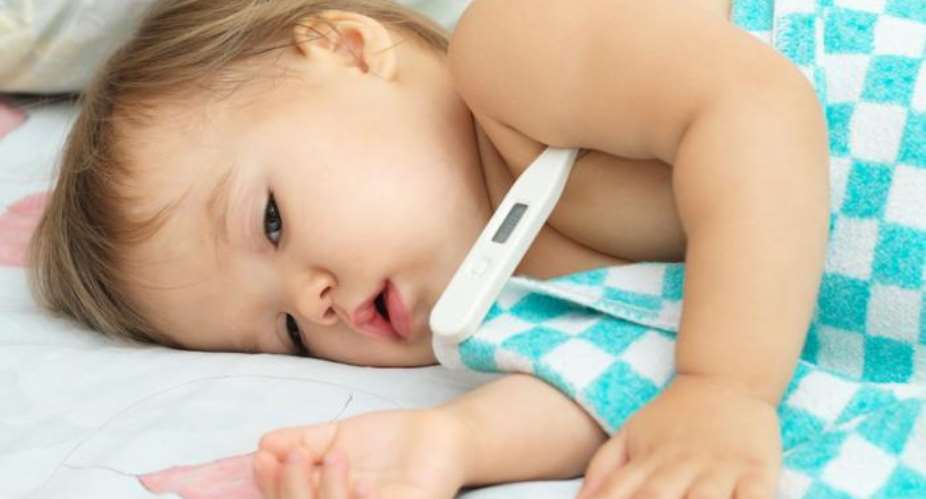Your first days and weeks with your newborn can be full of joy. However, this joy can be turned to uncontrolled worries and frustration when your child becomes sick. Babies cry a lot when they are sick and this is often noticed through their body temperature. A baby that has a fever will have a hot forehead and would likely to seem fretful and unhappy. A fever is abnormally high body temperature, of 380C (100.40F) or above. If you think your baby might be unwell, take his or her temperature.
We will take a critical and yet brief look at febrile convulsion in children. This is basically a type of seizure that affects some children from 6 months to 5 years. It is triggered by an unexpected rise in temperature, often at the beginning of a feverish illness in the child. Febrile convulsion usually lasts for less than 5 minutes.
Symptoms of Febrile Convulsion
Although frightening to some mothers, are not often serious. This type of seizure can be spotted by a couple of physical signs. During convulsion, a child may experience the following;
- Loses consciousness
- Stop breathing, temporary, or breathes shallowly
- Shake violently
- Roll back his or her eyes.
- Pass urine or baby poop
What to do when your child has a febrile convulsion
Febrile convulsion can be avoided and pretty much noticed. To avoid convulsion in children, it is always necessary to keep the child in a cool temperature. Here are a few ways to keep the child’s temperature down, especially, when the child has febrile convulsion;
- Remove clothes and bed sheets to cool him or her down
- Open the windows or use an electric fan for proper ventilation
- Surround him or her with a soft object such as a pillow
- Then, take your baby’s temperature
How do you take the temperature of a baby?
Well, first of all, you need a thermometer. With babies, it is necessary; you use the digital thermometer which is usually placed in the baby’s armpit. Alternatively, you could also use the aural thermometer which you place in the baby’s ears. I know you must have heard of Mercury thermometers, this type of thermometers are being phased out because they are not only difficult to read but can be hazardous to the environment as well. So avoid them.
Below are a few tips into checking your baby’s temperature;
- Check that the thermometer is turned on and ready for use
- Make sure it is clean or has disposable covers for the tip, that a fresh cover is fitted
- With babies, it is easier to take the temperature from the armpit than the mouth
- Place the tip of the thermometer in the bare armpit, with the arm keeping it in place
- Cuddle the baby to keep him or her still
- Leave for a few minutes following the instruction supplied by the thermometer and return to check the results.
When to call a doctor
Call an ambulance or visit the hospital if the child has a fever accompanied by any of the following;
- When your child has a high fever/ high temperature
- When the child has abnormal drowsiness
- When you notice flat, dark or purple spots that do not fade on pressure
- Most importantly, if your child refuses food for more than 3 hours, it is definitely recommended that you visit the nearest hospital.
Image source: mdicalnewstoday.com






 Lay KPMG audit report on SML-GRA contract before Parliament – Isaac Adongo tells...
Lay KPMG audit report on SML-GRA contract before Parliament – Isaac Adongo tells...
 Supervisor remanded for stabbing businessman with broken bottle and screwdriver
Supervisor remanded for stabbing businessman with broken bottle and screwdriver
 NDC watching EC and NPP closely on Returning Officer recruitment — Omane Boamah
NDC watching EC and NPP closely on Returning Officer recruitment — Omane Boamah
 Your decision to contest for president again is pathetic – Annoh-Dompreh blasts ...
Your decision to contest for president again is pathetic – Annoh-Dompreh blasts ...
 Election 2024: Security agencies ready to keep peace and secure the country — IG...
Election 2024: Security agencies ready to keep peace and secure the country — IG...
 People no longer place value in public basic schools; new uniforms, painting wil...
People no longer place value in public basic schools; new uniforms, painting wil...
 'Comedian' Paul Adom Otchere needs help – Sulemana Braimah
'Comedian' Paul Adom Otchere needs help – Sulemana Braimah
 Ejisu by-election: Only 33% of voters can be swayed by inducement — Global InfoA...
Ejisu by-election: Only 33% of voters can be swayed by inducement — Global InfoA...
 Minority will expose the beneficial owners of SML, recover funds paid to company...
Minority will expose the beneficial owners of SML, recover funds paid to company...
 Prof. Opoku-Agyemang has ‘decapitated’ the NPP’s strategies; don’t take them ser...
Prof. Opoku-Agyemang has ‘decapitated’ the NPP’s strategies; don’t take them ser...
